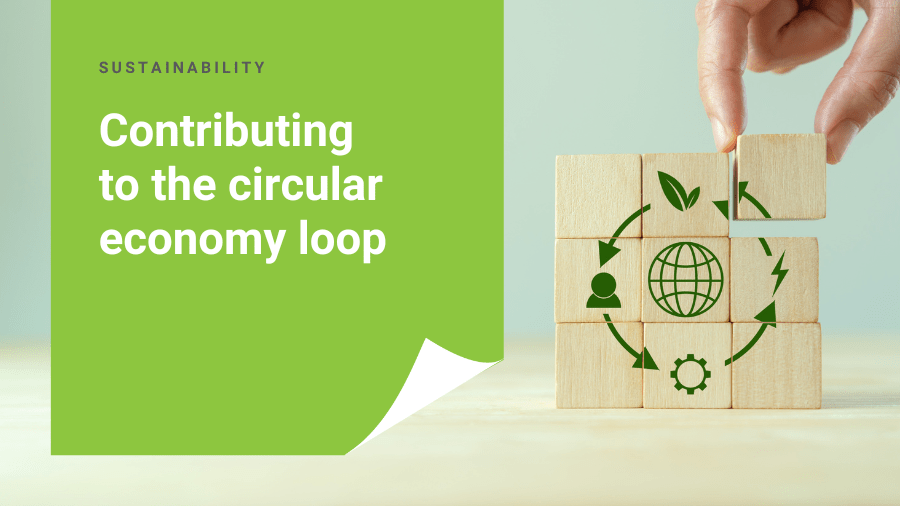With increasing attention to environmental impact, foodservice companies are adopting fibre-based trays, made from renewable materials such as bamboo, sugarcane and pressed paper, to participate in a more sustainable economy.
These packages don’t just replace single-use plastics; they play a key role in the circular economy, where every resource is fully exploited before returning to the earth, contributing to a more responsible system of production and consumption.
What is the circular economy, and why is it crucial?
The circular economy is an economic model that seeks to eliminate waste by reintegrating materials into a continuous production cycle. Unlike the traditional linear economy, which follows the “produce-consume-discard” pattern, the circular economy proposes a “reduce-reuse-recycle.” This means that products and materials are designed to be used for as long as possible, repaired, recycled or composted at the end of their useful life to minimize environmental impact and maximize resource efficiency.
In the foodservice sector, this approach is particularly relevant. By adopting renewable materials and integrating recycling and composting practices, companies can reduce their ecological footprint and meet growing consumer expectations for more sustainable solutions.
Fibre-based food trays: innovation for the circular economy
Created from renewable materials
Fibre-based food trays, made from bamboo, sugarcane or pressed paper, represent a significant advance in sustainable packaging design. These materials come from renewable sources: bamboo grows rapidly and regenerates without replanting, sugarcane is a by-product of sugar cane production, and pressed paper is derived from recycled paper or wood pulp, all valorized with sustainability in mind.
Using these renewable resources reduces dependence on petroleum-derived plastic materials, which are not only non-renewable but also difficult to recycle. What’s more, the production of fibre trays (bamboo, sugarcane, or pressed paper) generally consumes less energy and water than the manufacture of traditional plastics, further reducing their environmental impact.
Promoting responsible production and consumption
Fiber trays are not only made from renewable materials; they are also designed to minimize waste and encourage responsible consumption. Thanks to their ability to be recycled or composted, these trays fit perfectly into the circular economy loop, where every material is used to its full potential before returning to the earth.
This approach not only helps to reduce waste, but also encourages companies and consumers to rethink their relationship with single-use products. By adopting fiber trays, companies can demonstrate their commitment to sustainable practices and raise awareness among their customers of the importance of choosing packaging that does not end up in landfill, but is instead reintegrated into a natural or production cycle.
End-of-life recycling and composting
One of the most important advantages of fiber trays is their ability to be recycled or composted at the end of their life. Unlike plastics, which can take centuries to decompose and are often not recycled, bamboo, sugarcane and pressed paper trays decompose naturally in a composting environment in just a few months.
When these trays are composted, they turn into nutrient-rich compost that can be used to enrich agricultural soils. This not only reduces the amount of waste sent to landfill, but also contributes to the creation of a regenerative cycle, where materials return to the earth to support the growth of new renewable resources. In regions where industrial composting is not available, these trays can be recycled in suitable facilities, reintegrating the materials into the production chain in the form of new paper or fiber products.
Reducing waste and creating a regenerative cycle
By integrating fiber trays into their operations, food companies can play an active role in reducing waste and creating a regenerative packaging cycle. This cycle begins with the use of renewable materials, continues with optimized design to minimize waste, and ends with end-of-life recycling or composting.
This model not only reduces the environmental impact of food packaging, but also creates new economic opportunities. For example, organic waste from composting trays can be used to produce fertilizer, which in turn supports the growth of crops such as bamboo or sugar cane, closing the loop in a virtuous way.
Fiber-based food trays, whether made from bamboo, sugarcane or pressed paper, are a key innovation in the transition to a circular economy in the foodservice sector. By using renewable materials and enabling end-of-life recycling and composting, these trays help to reduce waste and create a regenerative packaging cycle. For companies, adopting these sustainable packaging solutions is not only a way of reducing their ecological footprint, but also of meeting growing consumer expectations for more responsible practices.
If you’d like to find out more about fiber food trays and how they can fit into your business model, contact us today. Our experts are here to guide you towards packaging solutions that combine sustainability and efficiency.

